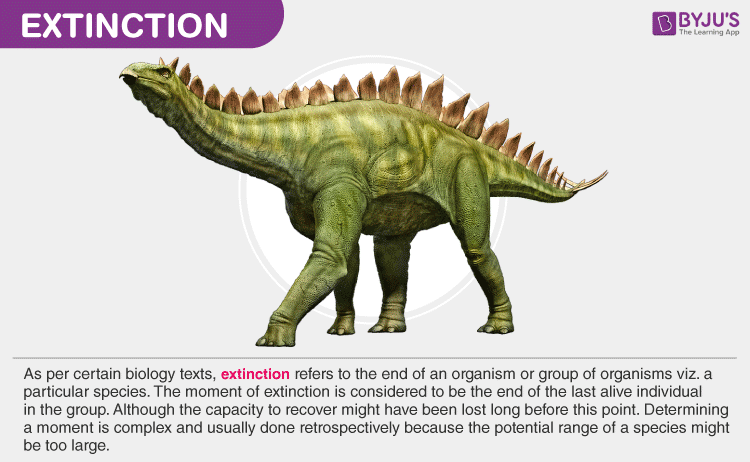“Extinction is the process of evolution that leads to the disappearance of a population or species.”

Table of Contents
What is Extinction?
When a species becomes extinct, all its genetic heritage is lost. The species evolve into new species in order to adapt to the environmental changes or changes in the genetic heritage.
Over 99% of all the species that once lived on the Earth, amounting to over five billion species, are estimated to be extinct. As per the estimations on the number of current species, a range from 10 -14 million, of which more than 1.2 million have been studied and more than 86% have not yet been discovered.
This could happen naturally due to a change in the climate or because of human activities like overhunting or the destruction of habitat.
Despite the uncertainties, extinction has three major elements.
- For species collectively, extinction is a probability if the killing stress is so rare beyond their experience and therefore outside the reach of natural selection.
- The mass extinctions would pave the way for the major restructuring of the biosphere where a few successful groups are eliminated, allowing minor groups to expand.
- In a few cases, there is evidence that extinction is selectively argued by Darwin. It has been made impossible to predict which species are going to be the next victim of an extinction event.

Also Read: Mass Extinction
Causes of Extinction
The important causes of extinction include:
Asteroid Strikes
A meteor strike on the Yucatan peninsula in Mexico led to the disappearance of dinosaurs millions of years ago. Most of the mass extinctions, such as KT extinction or Permian-Triassic extinction, were caused due to such events. Astronomers constantly keep an eye on comets or meteors that could lead to the end of human civilization.
Climate Change
Climate change is yet another factor that could destroy terrestrial organisms. During the end of the last ice age, most of the megafauna were unable to adapt to the changing warm temperatures. They died due to a lack of food and hunting by early humans. Even modern civilization is stepping towards the threat of extinction due to global warming.
Disease
Various epidemics had been the cause of the epidemic of a large population of humans and animals on earth. The Black Death wiped out one-third of the European population in the Middle Ages.
Loss of habitat
Every animal has its own comfort zone where it can breed and raise its young ones. For e.g., a bird is comfortable only on the branch of a tree. Due to the expansion of human civilization and industrialization, the forests have been destroyed, which are an abode to most animals. Due to lack of space and eventually food, the populations of many organisms have been minimised.
Lack of Genetic Diversity
Once the number of species starts decreasing, the gene pool of that species grows smaller. Eventually, there is a lack of genetic diversity. For eg., due to habitat loss, the African cheetahs have a considerably low genetic diversity.
Better Adapted Competition
The better-adapted populations win over the ones that lag behind. For eg., the pre-historic mammals were better adapted than the dinosaurs. The ones which are well-adapted survive, while the others become extinct.
Pollution
The pollution from industries and vehicles has led to a drastic change in the oxygen levels in the atmosphere as well as water. This has led to the extinction of most of the aquatic as well as terrestrial species.
Examples of Extinct Animals
Following are the important examples of extinct animals:
- Passenger Pigeon
- Dodo
- Tasmanian Tiger
- Baiji White Dolphin
- Pyrenean Ibex
- Stellers Sea Cow
- Great Auk
- Mammoth
- Sabre-toothed Cat
Also Read: Endangered species
To know more about what is extinction and the causes of extinction, keep visiting BYJU’S website or download BYJU’S app for further reference.
Frequently Asked Questions
What are endemic species?
Ex. The Large Ground-Finch is endemic to the Galapagos Islands.
What are endangered species?
Ex. The Asiatic Lion, the Bengal Tiger, and the Snow Leopard are endangered species in India.
What is the difference between endangered and extinct animals?
Example: Tiger, Wild Buffalo etc.
Extinct animals: The animals that no longer exist on Earth are called extinct animals.
Example: Dinosaurs, Dodo, etc.

Comments